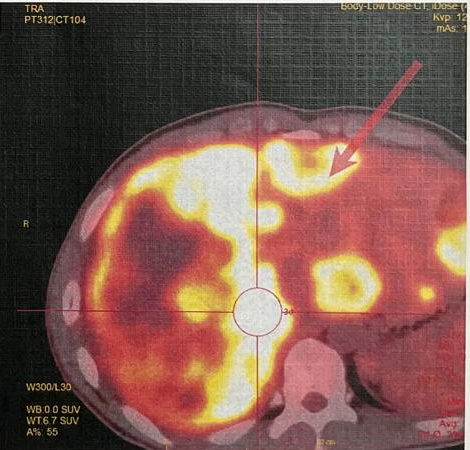Sunday Poster Session
Category: Biliary/Pancreas
P0247 - Growing Pains: Unusual Case of Cholangiocarcinoma in a Young Adult
Sunday, October 26, 2025
3:30 PM - 7:00 PM PDT
Location: Exhibit Hall

Gabriel Colon-Estarellas, MD (he/him/his)
San Juan City Hospital
San Juan, PR
Presenting Author(s)
Gabriel Colon-Estarellas, MD1, Tyffany Sebastian Hurtado, MD2, Pedro Rivas-Vega, MD1
1San Juan City Hospital, San Juan, Puerto Rico; 2San Juan City Hospital, Ponce, Puerto Rico
Introduction:
Cholangiocarcinoma is an aggressive malignancy that originates from the biliary epithelium, anywhere in the biliary tract from the intrahepatic biliary canaliculi to the terminus where the common bile duct enters the duodenum at the duodenal ampulla. This malignancy, which is 95% of the time adenocarcinoma, is often locally invasive or metastatic by the time it is detected. Usually predisposing factors include primary sclerosing cholangitis, parasitic infection of liver flukes, biliary tree calculi, cystic biliary lesions, chronic liver disease and genetic predisposition. Cholangiocarcinoma represents 3% of gastrointestinal malignancy and more common in men in ages 50-70 years.
Case Description/
Methods:
Case of 24 year old male with non-relevant past medical history, presents with episodic shortness of breath and low back pain that has been affecting daily life activities for the past 3 months. Symptoms are more notable on exertion. Patient first noted an intermittent, non-radiated low back pain after Crossfit training. Additional symptoms include, intermittent palpitations, constipation and unintentional 25 lbs weight loss during past month. Among imaging workup, chest computed tomography (CT) scan and Abdominal/Pelvic CT scan were remarkable for right large pleural effusion and hepatomegaly with multiple hypodense lesions. Lumbar MRI revealed L2 compression fracture and multiple lesions suggestive of malignancy. Positron emission tomography (PET) scan was also performed, which demonstrated disseminated nodules on hepatic, splenic, skeletal, and pulmonary regions. Clinical presentation and imaging studies are consistent with a malignancy with metastasis, without clear evidence of primary origin.
Discussion: Patient initially presented with low back pain, significant weight loss and a PET scan suggestive of lymphoma with skeletal, pulmonary, nodal, hepatic & splenic involvement. However, upon performing right pleural fluid cytology, differential of lymphoma seemed less likely, and immunohistochesmistry was suggestive of a pancreatobilliary neoplasia. Liver biopsy was performed to determine definitive diagnosis, which positive presence of a FGFR2 fusion was most consistent with an intrahepatic cholangiocarcinoma. Results were fundamental for identifying the primary tumor and indicating futibatinib as best choice of therapy as per genetic profile testing. Gene sequencing was key in providing targeted gene therapy as a precision medicine technique

Figure: Figure 1: Liver view of PET scan

Figure: Figure 2: Thoracic view of PET scan
Disclosures:
Gabriel Colon-Estarellas indicated no relevant financial relationships.
Tyffany Sebastian Hurtado indicated no relevant financial relationships.
Pedro Rivas-Vega indicated no relevant financial relationships.
Gabriel Colon-Estarellas, MD1, Tyffany Sebastian Hurtado, MD2, Pedro Rivas-Vega, MD1. P0247 - Growing Pains: Unusual Case of Cholangiocarcinoma in a Young Adult, ACG 2025 Annual Scientific Meeting Abstracts. Phoenix, AZ: American College of Gastroenterology.
1San Juan City Hospital, San Juan, Puerto Rico; 2San Juan City Hospital, Ponce, Puerto Rico
Introduction:
Cholangiocarcinoma is an aggressive malignancy that originates from the biliary epithelium, anywhere in the biliary tract from the intrahepatic biliary canaliculi to the terminus where the common bile duct enters the duodenum at the duodenal ampulla. This malignancy, which is 95% of the time adenocarcinoma, is often locally invasive or metastatic by the time it is detected. Usually predisposing factors include primary sclerosing cholangitis, parasitic infection of liver flukes, biliary tree calculi, cystic biliary lesions, chronic liver disease and genetic predisposition. Cholangiocarcinoma represents 3% of gastrointestinal malignancy and more common in men in ages 50-70 years.
Case Description/
Methods:
Case of 24 year old male with non-relevant past medical history, presents with episodic shortness of breath and low back pain that has been affecting daily life activities for the past 3 months. Symptoms are more notable on exertion. Patient first noted an intermittent, non-radiated low back pain after Crossfit training. Additional symptoms include, intermittent palpitations, constipation and unintentional 25 lbs weight loss during past month. Among imaging workup, chest computed tomography (CT) scan and Abdominal/Pelvic CT scan were remarkable for right large pleural effusion and hepatomegaly with multiple hypodense lesions. Lumbar MRI revealed L2 compression fracture and multiple lesions suggestive of malignancy. Positron emission tomography (PET) scan was also performed, which demonstrated disseminated nodules on hepatic, splenic, skeletal, and pulmonary regions. Clinical presentation and imaging studies are consistent with a malignancy with metastasis, without clear evidence of primary origin.
Discussion: Patient initially presented with low back pain, significant weight loss and a PET scan suggestive of lymphoma with skeletal, pulmonary, nodal, hepatic & splenic involvement. However, upon performing right pleural fluid cytology, differential of lymphoma seemed less likely, and immunohistochesmistry was suggestive of a pancreatobilliary neoplasia. Liver biopsy was performed to determine definitive diagnosis, which positive presence of a FGFR2 fusion was most consistent with an intrahepatic cholangiocarcinoma. Results were fundamental for identifying the primary tumor and indicating futibatinib as best choice of therapy as per genetic profile testing. Gene sequencing was key in providing targeted gene therapy as a precision medicine technique

Figure: Figure 1: Liver view of PET scan

Figure: Figure 2: Thoracic view of PET scan
Disclosures:
Gabriel Colon-Estarellas indicated no relevant financial relationships.
Tyffany Sebastian Hurtado indicated no relevant financial relationships.
Pedro Rivas-Vega indicated no relevant financial relationships.
Gabriel Colon-Estarellas, MD1, Tyffany Sebastian Hurtado, MD2, Pedro Rivas-Vega, MD1. P0247 - Growing Pains: Unusual Case of Cholangiocarcinoma in a Young Adult, ACG 2025 Annual Scientific Meeting Abstracts. Phoenix, AZ: American College of Gastroenterology.
